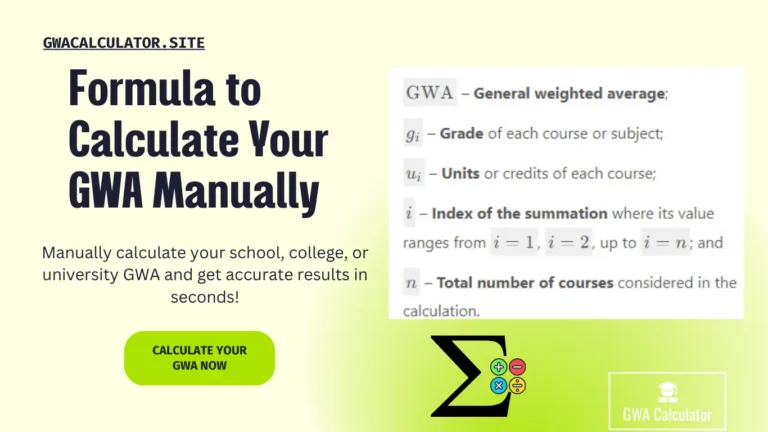PUP Grading System: A Guide for Students in the Philippines
As students progress through their academic journey, one of the most important aspects they must understand is the grading system used by their institution. For those studying at Polytechnic University of the Philippines (PUP), the PUP grading system is a key factor in determining academic performance, whether you’re a high school student transitioning to college or a university student looking to maintain your grades.
This guide provides a detailed overview of the PUP grading system, how it works, and how students can calculate their grades effectively.
What is the PUP Grading System?
The PUP grading system is a point-based system that assigns numerical values to a student’s performance in each subject. Grades range from 1.00 to 5.00, with 1.00 being the highest grade (Excellent) and 5.00 representing a failing grade. This system applies to both undergraduate and graduate students across different faculties and courses.
Here’s a quick overview of the PUP grading system equivalent:
| Grade | Equivalent | Remarks |
|---|---|---|
| 1.00 | 96-100 | Excellent |
| 1.25 | 93-95 | Very Good |
| 1.50 | 90-92 | Very Good |
| 1.75 | 87-89 | Good |
| 2.00 | 84-86 | Good |
| 2.25 | 81-83 | Satisfactory |
| 2.50 | 78-80 | Satisfactory |
| 2.75 | 75-77 | Fair |
| 3.00 | 70-74 | Passing |
| 4.00 | Conditional | Passing Grade |
| 5.00 | Below 70 | Failed |
How Does the PUP Grading System Work?
At PUP, grades are calculated based on students’ performance in exams, quizzes, written assignments, projects, and class participation. Each of these components contributes to the final grade, which is then transmuted into the corresponding grade in the PUP grading scale.
Here’s a breakdown of how grades are typically computed:
- Raw Scores: Students receive raw scores for each of their assessments (e.g., quizzes, midterms, finals).
- Weightage: Each assessment carries a different weight. For example, final exams might contribute 40% to the final grade, quizzes 20%, projects 20%, and participation 20%.
- Final Grade: The weighted scores are combined to calculate the final raw score. This raw score is then matched with the corresponding grade in the PUP grading scale.
Grade Transmutation in PUP
The PUP grade transmutation process is crucial for standardizing grades across all subjects. After calculating a student’s raw score, the grades are often transmuted into the final grade that appears on the report card. This transmutation ensures fairness across different departments and faculties, particularly in cases where certain subjects may have more difficult assessments.
The PUP grading system also takes into account specific guidelines for conditional grades (4.00), which means that a student may have to retake an assessment or subject to pass.
PUP Grading System Equivalent
The PUP grading system equivalent refers to how the university’s numeric grades compare to other educational institutions or grading systems, such as those in high school or other colleges in the Philippines. For instance, a grade of 1.00 in PUP may be equivalent to an A in other grading systems, while a 5.00 is equivalent to an F or a failing mark.
For students who are transferring to other universities or applying for scholarships, it’s important to understand how PUP grades compare to other institutions’ grading standards. Many universities use a similar scale, but the exact conversion can vary.
Why Understanding the PUP Grading System Matters
- Academic Performance: Understanding how the PUP grading system works helps students track their academic performance and set realistic goals. If a student aims for honors or other academic achievements, knowing the grade equivalent can help them strategize and allocate more time to subjects that require improvement.
- Scholarships and Applications: Many scholarship programs and graduate schools require students to maintain a certain GPA. Understanding your PUP grades equivalent can help when applying for scholarships both locally and internationally.
- Academic Standing: In PUP, students are expected to maintain a minimum GPA to stay in good academic standing. Failing to meet these requirements can lead to probation, retaking courses, or even disqualification.
How to Calculate Grades in PUP
To compute your grades manually using the PUP grading system, follow these simple steps:
- Calculate Your Weighted Average:
- Assign each assessment component its respective weight (e.g., quizzes might be 20%, exams 40%, etc.).
- Multiply your score in each assessment by its weight. For example, if you scored 85 on your midterm exam and it’s worth 30%, you would compute: 85×0.30=25.585 \times 0.30 = 25.585×0.30=25.5
- Sum the Weighted Scores: Add all the weighted scores to get your total grade.
- Transmute Your Score: Once you’ve calculated the weighted score, refer to the PUP grading system equivalent table to determine your final grade.
Tips for Succeeding in the PUP Grading System
- Prioritize Heavier Assessments: If final exams or projects carry a larger weight, allocate more time and effort to these tasks. This strategy can significantly improve your overall grade.
- Maintain Consistency: Don’t neglect quizzes, participation, or smaller projects, as these still contribute to the final grade. A balance between all assessments ensures you have a strong base.
- Use Grade Calculators: To avoid surprises at the end of the semester, use online grade calculators or consult with your professor to keep track of your progress.
- Seek Academic Support: If you find yourself struggling with certain subjects, don’t hesitate to ask for help. PUP offers academic support services that can help students improve their performance.
Frequently Asked Questions (FAQs)
Q: What is the passing grade in PUP?
A: The passing grade in PUP is 3.00, which is equivalent to a score between 70 and 74.
Q: What does a grade of 5.00 mean?
A: A grade of 5.00 is a failing mark and indicates that the student’s score was below 70.
Q: What happens if I get a 4.00?
A: A 4.00 is a conditional passing grade, which means the student may need to take remedial action, such as retaking an exam or additional assignments, to convert the grade to a passing mark.
Q: How do I calculate my GPA in PUP?
A: To calculate your GPA in PUP, sum the weighted grades of all subjects, then divide by the total number of units taken.
Conclusion: Mastering the PUP Grading System
Understanding the PUP grading system is key to succeeding in your academic journey. Whether you’re aiming for honors, trying to maintain good standing, or planning to apply for scholarships, keeping track of your grades and knowing how they are computed can make all the difference.
By being proactive in tracking your academic performance, utilizing the grading system to your advantage, and understanding how your grades are transmuted, you can navigate the challenges of university life with confidence.







